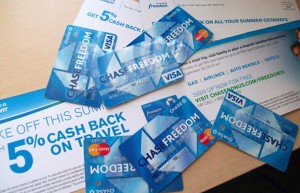6 credit card pitfalls for young people
1.) Falling for the marketing ploys
Some credit card companies and issuers have rather aggressively been targeting young people in the United States with various marketing campaigns, including campaigns where you get free pizza if you apply for a credit card. Laws have been enacted to weed out some of the worst marketing ploys, but credit card companies and issuers are still spending millions to attract young people as clients.
 The problem with signing up for whatever credit card happens to be marketed on your college campus or favorite hang-out spot is that you’re not making an informed decision. You are not choosing the credit card that is best for you – you are choosing a credit card based on a nifty marketing campaign. Sure, you might luck out and end up with a credit card that suits you well, but you might just as well get stuck with a credit card that is supremely inferior to other credit cards that you could have been approved for if you had just taken charge and done your own due diligence.
The problem with signing up for whatever credit card happens to be marketed on your college campus or favorite hang-out spot is that you’re not making an informed decision. You are not choosing the credit card that is best for you – you are choosing a credit card based on a nifty marketing campaign. Sure, you might luck out and end up with a credit card that suits you well, but you might just as well get stuck with a credit card that is supremely inferior to other credit cards that you could have been approved for if you had just taken charge and done your own due diligence.
Do not settle for a credit card just because it happens to be marketed in front of your nose. Sit down, take a look at your budget and how you spend money at this stage of your life, and start actively searching for a credit card that suits your particular lifestyle. If you have no car, going for a credit card where the main selling point is 3% cash back on gas is probably not in your best interest. If you on the other hand know that you will be spending a semester abroad, pay special attention to credit cards that offers $0 foreign transaction fees and comes with good complimentary travel insurance.
2.) Paying annual fees
Many young people have relatively small budgets. If this pertains to you, than getting a credit card with an annual fee is probably not worth it. There are great credit cards out there with annual fees, but they typically cater to a different consumer segment, e.g. business persons that travel a lot by air and need an excellent rewards program for frequent flier miles. If you are on a small budget, you will probably not be able to take enough advantage of the perks to make up for the annual fee.
3.) Overspending
This is a very common pitfall for credit users of any age. Access to credit means a possibility of overspending. Since credit cards tend to come with a very high interest rate for any part of the bill that isn’t paid in full each month, buying more than you can afford to pay for right away can quickly suck yo down into a debt trap. You will soon be paying interest on interest (compound interest), and your total debt amount can snowball out of control.
4.) Believing you have to pay interest to build credit history
A common misconception among you people is that you have to carry a balance and pay interest to build a credit history. That somehow, a credit card bill that is paid in full each month won’t count as “real” credit and won’t help you build credit history.
 This is a really harmful misconception, because the exact opposite is true. Paying your credit card balance in full each month will not only help you build credit history, but will also have a large beneficial impact on your credit score.
This is a really harmful misconception, because the exact opposite is true. Paying your credit card balance in full each month will not only help you build credit history, but will also have a large beneficial impact on your credit score.
Also, by habitually paying your credit bill in full each month, you reduce the risk of doing things that might end up hurting your credit history and credit score, such as late payments and utilizing more than 30% of your total available credit.
There are situations where using a credit card to pay of something over several months can make sense for a young person. You might for instance be starting college with very little financial resources available to you, and you need to purchase several expensive course books at the start of the semester. In this case, ideally look for one of the credit cards that give new users a welcome gift in the form of no APR on purchases during the introductory term, e.g. during the first 6 months or first 12 months. This way, you can pay back gradually without being charged interest.
A credit card with a good introductory offer can also be a good idea if you have racked up debt on a credit card with a high APR and wants to pay that one of right away. You can use the new credit card to pay off the old credit card, and then gradually pay off your debt during the interest free intro term. Of course, this requires discipline because if you don’t actually pay down your debt you will be in a new bad situation when the intro term is over – and this time it might be tricker for you to be approved for a new credit card. You don’t want to end up in a situation where you are desperate to be approved for a new credit card every 6th month, because all these applications for new credit cards will damage your credit score and make it increasingly difficult for you to be approved for new credit.
5.) Utilizing more than 30% of your available credit
When potential lenders look at your credit report, one of the things that they are likely to pay special attention to is your utilization ratio, i.e. how much in debt you have in relation to how large your combined lines of credit are.
Example: You have one credit card with a $4,000 limit and another credit card with a $1,000 limit. You owe $1,000 on the first card and $900 on the other card. (1000 + 900) / (4000 + 1000) = 0.38 This means that you utilization ratio is 38%.
 It is best to keep your utilization ratio below 30%. If your utilization ratio is higher than this, it can cause your credit score to drop, and potential lenders might see you as someone with low creditworthiness. A utilization ratio below 30% but above 10% will usually have no negative impact on your credit score, and a utilization ratio below 10% can even have a positive impact on your credit score.
It is best to keep your utilization ratio below 30%. If your utilization ratio is higher than this, it can cause your credit score to drop, and potential lenders might see you as someone with low creditworthiness. A utilization ratio below 30% but above 10% will usually have no negative impact on your credit score, and a utilization ratio below 10% can even have a positive impact on your credit score.
Now, let’s say, that in the example above, the credit card issuer of card #2 would increase your limit from $1,000 to $3,000. (1000 + 900) / (4000 + 3000) = 0.27. All of a sudden, your utilization ratio would be 27% and you would be perceived as someone with a higher creditworthiness than before.
Utilization ratio can make up a very large chunk of a person’s credit score, so keeping our utilization ratio below 10% is really important if you want to build up your credit score. If you already have a high credit score and is okay with simply maintaining it, a utilization ratio below 30% will usually suffice.
6.) Only using your credit card for emergencies
Many adults want their children to have a credit card but only to use in emergencies. Imprinting this idea on your children that credit cards are only do be used in dire circumstances is actually doing them a disservice, since it will prevent them from using the credit card to build up their credit score and put together some credit history while still young. If you child has no students loan, auto-loan or similar, the credit card might actually be one of few venues for the young person to build a credit history and increase his or her credit score early on.
Having credit history and a high credit score can help a young person in various ways. It might for instance be easier to rent an apartment without a cosigner. Also, a young adult that has already built credit history and a good credit score will find it easier to negotiate for an auto-loan and house mortgage loan with good T&C’s when she reaches that stage of her life.
Therefore, it is a good idea for a young person to actively use the credit card for everyday purchases – but within his or her means. If you are a young person wishing to create credit history and boost your credit score, use the credit card to pay for things that you have to purchase anyway, and make sure to set money aside so that you can pay the bill in full before it’s due date each month.
